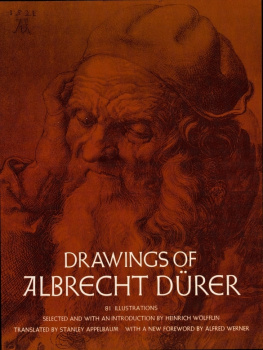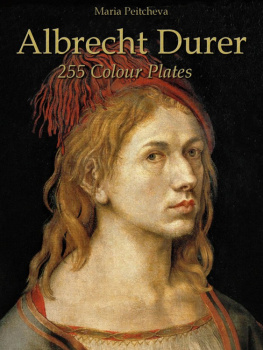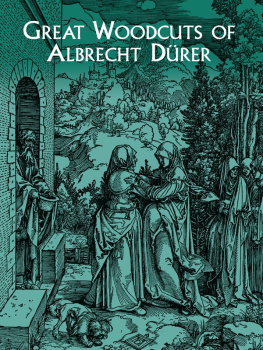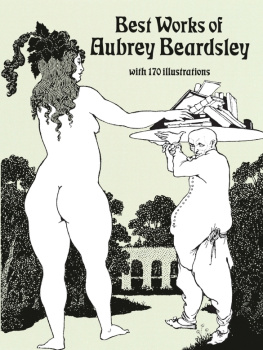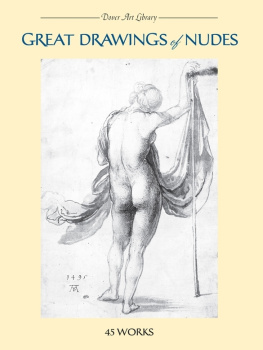Drawings of Albrecht Dürer
Here you can read online Drawings of Albrecht Dürer full text of the book (entire story) in english for free. Download pdf and epub, get meaning, cover and reviews about this ebook. year: 2012, genre: Science fiction. Description of the work, (preface) as well as reviews are available. Best literature library LitArk.com created for fans of good reading and offers a wide selection of genres:
Romance novel
Science fiction
Adventure
Detective
Science
History
Home and family
Prose
Art
Politics
Computer
Non-fiction
Religion
Business
Children
Humor
Choose a favorite category and find really read worthwhile books. Enjoy immersion in the world of imagination, feel the emotions of the characters or learn something new for yourself, make an fascinating discovery.
- Book:Drawings of Albrecht Dürer
- Author:
- Genre:
- Year:2012
- Rating:3 / 5
- Favourites:Add to favourites
- Your mark:
- 60
- 1
- 2
- 3
- 4
- 5
Drawings of Albrecht Dürer: summary, description and annotation
We offer to read an annotation, description, summary or preface (depends on what the author of the book "Drawings of Albrecht Dürer" wrote himself). If you haven't found the necessary information about the book — write in the comments, we will try to find it.
Unknown: author's other books
Who wrote Drawings of Albrecht Dürer? Find out the surname, the name of the author of the book and a list of all author's works by series.
Drawings of Albrecht Dürer — read online for free the complete book (whole text) full work
Below is the text of the book, divided by pages. System saving the place of the last page read, allows you to conveniently read the book "Drawings of Albrecht Dürer" online for free, without having to search again every time where you left off. Put a bookmark, and you can go to the page where you finished reading at any time.
Font size:
Interval:
Bookmark:
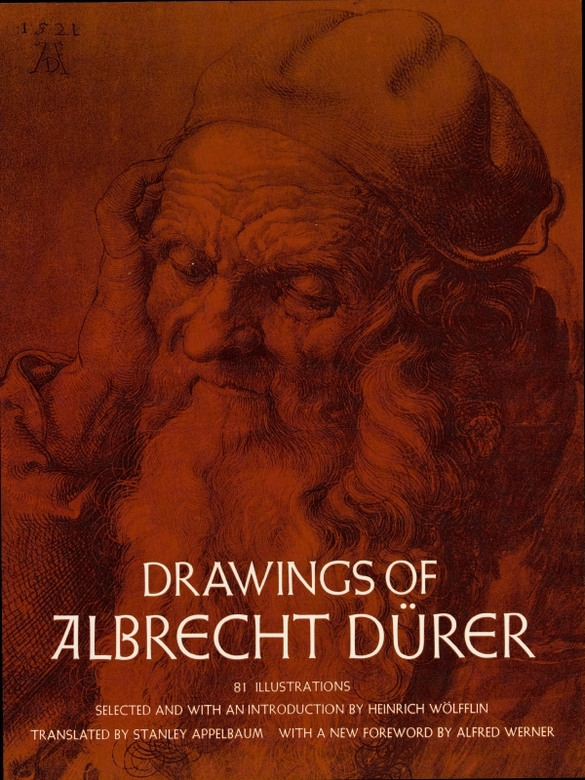
T he historical significance of Drer as a draftsman lies in his construction of a purely linear style on the foundation of the modern three-dimensional representation of the real world. All drawing moves between the two poles of expression by line and expression by tone areas or masses. In the latter, of course, line need not be wholly absent, but it does not become important for its own sake. Rembrandt used the pen, too, yet the individual pen stroke is not present as a final end operative in its own right, but as an element incorporated into the impression made by the drawing as a whole. The viewer does not follow the course of the individual line, and cannot do so, because the line stops every moment, shifting his attention, or else becomes complicated to the point of inextricability: the masses are to convey the message, not the framework of lines itself. With Drer it is just the opposite; the drawing is a crystal-clear configuration in which every stroke, rendered pure and perspicuous, not only has the function of defining forms, but possesses its own ornamental beauty. It is not enough to praise the power of Drers line and to ascertain that the expression is entirely entrusted to the interconnection of the major lines and the even flow of their directionality: there is, beyond this, the development of the stroke as an element in a decorative overall figure.
This style is not present at the outset. The fifteenth century did not yet possess it, and there are early drawings of Drer which have a more painterly appearance than his later classic drawings. It is conceivable that modern sympathies may even lie more with those youthful works, but this does not alter the fact that it was the pure linear style that made Drers draftsmanship the cornerstone of sixteenth-century art.
There are no lines in nature. Any beginner can learn this if he sits down in front of his house with a pencil and tries to reduce what he sees to a series of lines. Everything opposes this task: the foliage on the trees, the waves in the water, the clouds in the sky. And if it seems that a roof clearly exposed against the sky, or a dark tree trunk, must surely be able to be rendered in outline, even in these cases it is soon apparent that the line can only be an abstraction, because it is not lines that one sees, but masses, bright and dark masses that contrast with a background of a different color. After all, there are no black threads running along the edges of objects!
It is extremely strange that nevertheless it is possible to wrest an expression in line from the real world. Our eyes have become accustomed to linear abstraction; thanks to the efforts of generations, there is a language of line in which everything or at least practically everything can be said. And Drer is one of the great discoverers; he extended the expressiveness of line in all directions and found the unsurpassable formula for rendering certain phenomena.
There are two senses in which we speak of lines in drawing: there are contour lines and there are modeling or shading lines.
There are contours in every drawing, but the greater or lesser accentuation of these contours makes a great difference. The more significance they have for the definition of formthat is, the more the figure approaches an objective silhouettethe greater significance the contours will have in comparison with the other lines. (By silhouette is meant not only the overall outline of a figure; inner forms also have their silhouette.) The significance of the contour line is further increased when it gains independence as a melodic voice. That is what happened in the sixteenth century. Now more, now less emphasized, the contour nevertheless is always a sure and clearly marked path. Beautiful in its own right, it contains the interpretation of the form.
Wherever this linear style turns toward the painterly, the contour quickly loses its importance. The eye is hindered in every way from using it as a path for observation. Finally all that is left, as resting places on the old road, is a few isolated line fragments or dots.
In its second application, line is used to achieve modeling. To be sure, line is not a self-evident means of representing light and shade, but the viewer raises no objection to seeing the dark area of a vaulted surface, or the part of a room that lies in shadow, transformed into a system of individual strokes. Here too the sixteenth century is the first century of decided linearity. Whereas previously longer or shorter strokes were placed side by side and one above the other to indicate the form of a mass, the technique becomes refined toward the close of the fifteenth century, and the classic linear artists make it their rule that the line systems of shaded areas be kept perfectly transparent and open, so that each individual stroke carries its own weight. Once again clarification of form and decorative beauty go hand in hand. The stroke that models is felt to be ornamental, but at the same time its movement is conditioned by the necessity for the course of the line to follow the given form. The line in a vaulted form is different from that in a flat form, an empty dark area in a room is not characterized in the same way as the shadow cast by a body. In fact, it is possible to communicate the qualities of textures by purely linear means, to express hardness and softness, the muscular firmness of a mans thigh and the gentle manner in which a womans body yields to the touch.
Then, under the influence of painterly tendencies, the schema becomes confused. The individual line is lost in the overall mass. Alienated from form, it no longer retains any special ornamental significance, and only the large-scale rhythm of clusters and tone areas is left to tell the story. The drawing has forfeited its transparency, but in the same measure its power to differentiate textures has grown, and dark and light have acquired a mysterious life of their own.
Drer used a great variety of media. There are pen drawings and brush drawings; he worked with charcoal and chalk; and alongside a lead-like metal point the older silverpoint is also to be found. The tools change according to time and occasion. For example, whereas the silverpoint became more and more Drers instrument during his travels and for quick sketching en route, it must be said that in his later years chalk had the same significance as the brush in his middle period. Throughout the years, however, the pen remains Drers favorite drawing tool: it is especially well adapted to satisfy the urge to give independent life to the individual strokes.
It is unusually stimulating to follow the course of the separate treatment of each technique in Drers work. Each time, when confronting nature, Drer sets himself another problem, and the results achieved by a chalk drawing, for example, are basically different from those required of a pen drawing. Naturally, the final purpose of the drawing is the deciding factor. Studies for figures in a painting will not look like preliminary drawings for a woodcut. This is not to say, however, that the graphic style of the print has won a determining influence over the drawing; in fact, the opposite is the case: Drer raised the woodcut to the level of pen drawing, his pen drawing.
Drers drawings should not be judged by naturalistic standards. They can never be viewed fairly if their fundamentally different intention is not understood: Drer strives everywhere for a linear organism that is both decorative and independent, and the drawing consciously departs from natural appearances, sometimes more, sometimes less. There are flourishes and coloratura passages in this art, heightenings and sharpenings of the line that serve only to give the needy linear system a value of its own in confrontation with nature. Yet the beauty of the whole is not in the figure alone, but in the network of lines in which the figure is, to an extent, enmeshed.
Font size:
Interval:
Bookmark:
Similar books «Drawings of Albrecht Dürer»
Look at similar books to Drawings of Albrecht Dürer. We have selected literature similar in name and meaning in the hope of providing readers with more options to find new, interesting, not yet read works.
Discussion, reviews of the book Drawings of Albrecht Dürer and just readers' own opinions. Leave your comments, write what you think about the work, its meaning or the main characters. Specify what exactly you liked and what you didn't like, and why you think so.

